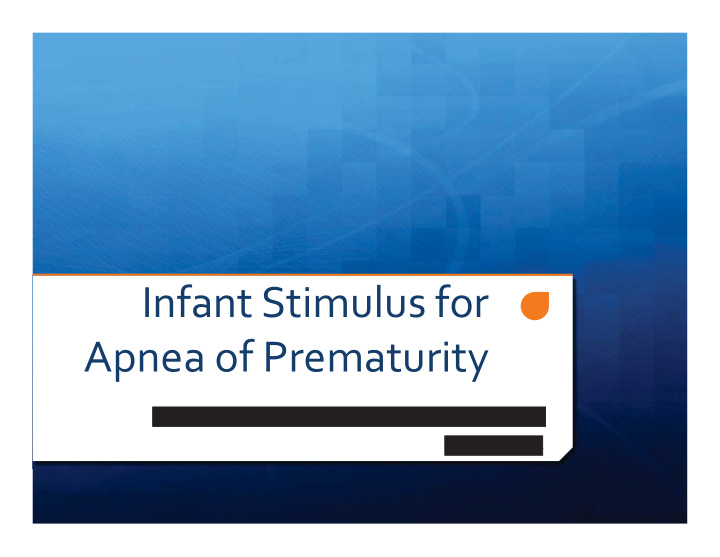



Infant Stimulus for Apnea of Prematurity Wesley Jones, Ivey Barnes, Jake Henke, Adam Evans 9 October 2012
Biofeedback Solutions Introductions & Titles Ivey Barnes Jake Henke Chief Operations Officer Chief Engineering Officer Team Leader Chief Marketing Officer wbarnes6@utk.edu jhenke1@utk.edu Adam Evans Wesley Jones Chief Research Officer Chief Technology Officer Chief Financial Officer Chief Creative Officer aevans27@utk.edu wjones18@utk.edu
Explanation of Issue � Apnea: stopped breathing during sleep � Event also occurs in premature infants � Current intervention: infant gently stimulated by hand
Background Proposed solutions � Stimulation device that is ‘stuck’ on or comes in direct contact with the infant � Stimulation device located on infant’s foot � Response to taste/smell and tactile stimulation during apneic episode � US Patent 5,555,891: Vibrotactile stimulator system for detecting and interrupting apnea in infants � US Patent 4,630,614: Apnea monitoring apparatus
Stakeholder Requirements As per Dr. Stephens’ input � The device must be able to: Quickly detect an apneic episode • Quickly respond to a sensed apneic episode • Potentially : prevent apnea • � Furthermore, the device must not : Use electric stimuli • Be injurious to the skin of the premature infant • Interfere with current equipment/tubing/cords •
Graphic of Feedback Loop
Design Input & Tech Spec’s Monitoring Equipment: � Accurately & constantly monitor an output that is capable of differentiating apnea versus no apnea � Be non-invasive of cabling, tubing, and other equipment currently in use Raspberry Pi/Microcomputer: Detect apnea versus no apnea by instantaneously analyzing the � data that is output to it by the monitoring equipment Signal the stimulation device in the event that apnea is detected � Stimulation Device: Non-invasive as possible � Effective stimulation so as to disrupt apneic episode �
Societal Implications & Concerns � Cost of device, given medical equipment product requirements Specialized materials (hydrogels, etc.) • � Safety concerns, given product application � FDA and IRB approval � Testing the device will be a challenge � Manufacturing concerns include sterilization of patient- contacting parts � Sustainability: some parts disposable, some re-usable � Scope: implementation at UT Graduate School of Medicine
Overall Project Timeline
QUESTIONS?
Recommend
More recommend